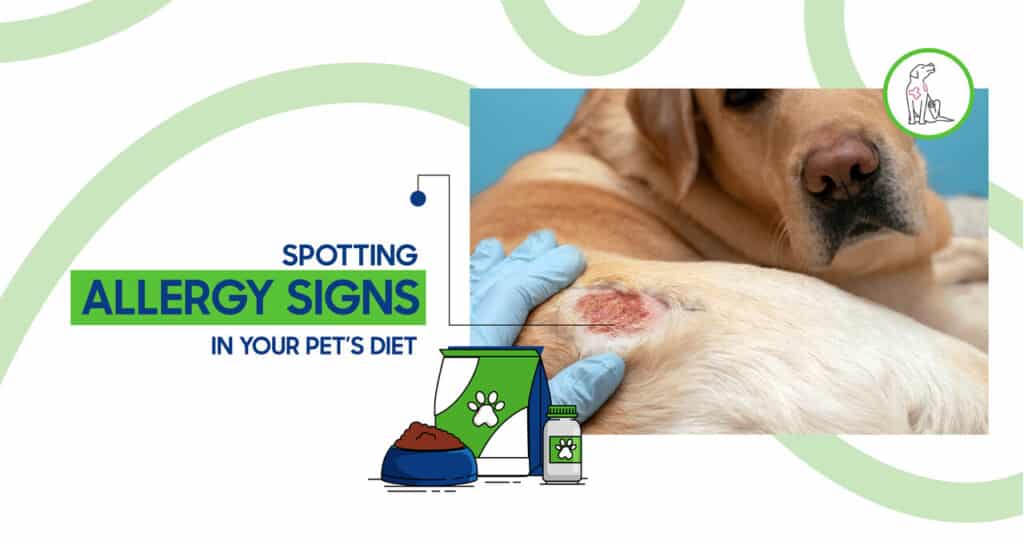This may be puzzling, frustrating, and hard to manage in your pets. Pets are almost like humans who get exposed to food allergies that will give them uncomfortable situations as well as severe health complications if not addressed properly. Any pet owner should define how to trace the symptoms of food allergies in pets, what can become an allergen for pets, and how to correctly react to a pet when this issue occurs. This article will help you know what food allergies in pets are, how to establish them, and how to treat and manage them to the best health possible of your pet.
What Is a Food Allergy?
However, before listing symptoms, one must know what a pet food allergy is. A food allergy is an overreaction by a pet’s immune system that considers a normally innocuous ingredient something bad. To counteract the perceived threat, chemicals, including histamine, are released from the immune system, producing allergic reactions. Unlike food intolerances, which are indeed forms of digestive disorders, food allergies stimulate an immune response.
Food allergies can arise at any time in a pet’s life. The best way to diagnose this condition is to look for changes in health or behavior. Food allergies are quite common in pets, but their knowledge of the difference between food allergies and environmental allergies or infections makes them necessary.
Proteins- beef, chicken, lamb, wheat, corn, and dairy products – are common allergens. Knowing these will help you take precautions against your pet’s allergies.
The Mechanism Behind Pet Food Allergies
Sometimes, it is even more bizarre because your pet may have been eating that food for years without any adverse reaction but then become allergic to one ingredient. This is when the immune system identifies that ingredient as foreign and dangerous and starts producing antibodies. The moment that your immune system gets sensitized to that particular allergen, it starts reacting with that food.
Yet, the most common allergens are proteins from beef, chicken, or fish. Grains include wheat and corn as common culprits, though less of a source than proteins in pets. Even preservatives or artificial additives may sometimes be the causative agent of allergy in animals.
What Are the Signs of Food Allergies in Pets?
There are different symptoms of food allergies that might emerge if your pet suffers from the disease. These could be detected earlier so one could act before it inflicts a serious impact from the allergy. It is middle to extreme and affects lots of body parts.
Skin Problems
The most common symptoms for commercial pet food allergies are actually of a skin-related type and include:
- Itching. The pet starts scratching, mainly at specific parts of the body, such as ears, face, paws, or belly.
- Red, inflamed skin. The skin looks red or shows irritation from some scratching, licking, or biting.
- Hot spots. Are inflammatory and infected areas due to an allergic reaction or continuous scratching/licking?
- Hair loss. Your pet can develop hair loss in certain areas because chronic itching is a direct reaction.
Digestive Issues
Food allergies also cause digestive disturbances. If your pet seems to manifest some of the given symptoms, then a food allergy may be the cause.
| Vomiting | Repeated vomiting after eating meals may be an indicator that the stomach reacts to certain foods’ ingredients. |
| Diarrhea | Loose, watery stools may be another sign that your pet’s body is rejecting something in their food. |
| Bloating | Bloating is a swollen or distended belly that can be associated with gastrointestinal discomfort. It is usually caused by food allergies. |
Behavioral Changes
Pets often change their behavior if they become affected by food allergies. They simply become irritable or, vice versa, lethargic because of the discomfort involved as a result of an allergic reaction. Sometimes, the whole itching and gastrointestinal upset that your pet is suffering just makes it anxious or restive.
Respiratory Issues
Some pets might even get respiratory signs like sneezing coughing, or wheezing. It is true, though not very frequent that some pets may undergo an allergic reaction that presents itself with such kinds of symptoms resulting from a food allergy.
Swelling and Rashes
Food allergies can sometimes result in swelling of some areas like the face, paws, or ears of some pets. Hives and rashes on the skin usually occur due to proteins or grains in pets’ food.
How to Diagnose and Treat a Food Allergy?
If any of these symptoms occur in your pets, consult with your vet about how best to make a correct diagnosis and provide the necessary treatment. Since the diagnostic procedure for this food allergy involves an elimination process, the proper diagnosis usually requires a little time.
The Role of a Pet Food Allergy Test
The first point of call would then be a visit to your vet. Your vet will take a test for pet food allergy and will be able to state what specific allergen would affect your pet. A blood test or even skin testing will point to the food ingredients that cause those allergic reactions.
In addition to testing, your veterinarian may recommend an elimination diet. This involves feeding your pet a special, hypoallergenic food that contains only a few simple ingredients, none of which they have been exposed to before. Over time, you’ll gradually reintroduce other ingredients to see if any cause a reaction. This method can help pinpoint the exact cause of your pet’s allergy.
Treatment Options for Pet Food Allergies
You then refer a pet to a veterinarian and decide together the best course of treatment since the allergen has been discovered. The key treatment for a pet food allergy involves the exclusion of the offending ingredient, and this usually means changing to a diet of hypoallergenic food and, in certain cases, food diets proven to have limited ingredients. Sometimes, the prescription diets that vets recommend are for pet allergies.
For those pets that respond pretty negatively, a veterinarian may prescribe antihistamines, corticosteroids, or other types of immunomodulatory drugs to help regulate a range of symptoms related to such allergic reactions, like itch, inflammation, and several more.
Switching to the Right Food
Once you know what your pet may be allergic to, it shouldn’t be tough to find the food for pets with allergies for the first time. Start searching for your pet’s allergy diet without common allergens such as beef, chicken, or even grains. There are quite a few such good diets so that their symptoms begin reducing.
Specific diets are also developed for skin-allergic dogs, like the best pet food for dogs with skin allergies, which contains novel protein sources and low levels of usual allergens to suppress inflammation and promote healthy skin.
The Importance of Gradual Transitions
When a pet is accustomed to some type of food, change should be done gradually because allergy symptoms and food intolerance overlap when the diet of a pet is changed suddenly. Mix increasing proportions of the new food into your pet’s diet over a week by diluting the old one.
Food Allergy Triggers in Pets
It is precisely identifying the ingredients causing reactions to the food that makes a difference between a pet food allergy. These include common allergens such as:
| Proteins | They are beef, chicken, lamb, and fish. In this condition, pets turn allergic to at least one of the protein types stated above, and beginning signs and symptoms show as skin rashes or vomiting/diarrhea. |
| Grains | Commercial products mostly use wheat, corn, and soy. This makes for a lousy filler in cases where animals may have allergic responses to those grains, creating an imbalance that could cause digestive disorders or even dermatological infections. |
| Dairy Products | Some pets are lactose intolerant, others are allergic to dairy proteins. The problem most likely manifests in problems with the digestive and skin. |
| Artificial Additives | Artificial Additives include preservatives, colorings, and flavor enhancers, which could also cause an allergic reaction in animals. Those are mostly occurring in lesser-quality pet foods. |
Some Common Allergy Triggers in Dogs
Some common protein allergens found in the typical dog diet are beef, chicken, and lamb. Other dogs tend to be hypersensitive to grains. Wheat and corn, in particular, seem to be culprits when it comes to itchy skin, digestive upset, or ear infections. A lot of dog owners who want to feed the best pet food for dogs with skin allergies end up going with grain-free food or at the very least, food sources with novel protein such as venison or duck. They are less likely to cause allergic reactions in sensitive dogs.
If you suspect that your dog suffers from some kind of food allergy, switch the diet to a particularly prepared one for allergy sufferers. Choose pet food for dogs with allergies with a few ingredients and with the highest quality of proteins to minimize the possibilities of reaction while still delivering proper nutrition for your dogs.
Some Common Allergy Triggers in Cats
Similarly, food allergy affects cats, though the main offenders differ from those in dogs. Many cats are sensitive to various animal proteins, especially beef, chicken, and fish. Dairy products can be a source of allergies as well, mainly milk. For allergic cats, there should be high-quality protein-sensitive food that eliminates such allergens.
Look for food for pets with allergies, focusing on the needs of a feline cat that may suffer from food sensitivities. Hypoallergenic foods can help make a lot of difference in case the cat has skin allergies or other problems of the gastrointestinal tract.
Final Discussion on Spotting Allergy Signs
The most crucial problem with diet for your pet is catching any allergic signs as soon as you can. You should know what signs and probably the triggers of food allergies and other kinds of treatments when it comes to handling your pet’s allergy. If you think that your pet is suffering from a food allergy, then immediately visit your vet and get a pet food allergy test done to figure out what the real cause is.
Call to Action:
If your pet is displaying any signs of food allergies, then it’s time to do something. Call your vet today and check out some of our products for pet food for dogs with allergies, as well as a few other allergy-friendly products that can be used. Click here to shop for your pet’s health and comfort!
FAQs
-
What are the most common signs of pet food allergies?
The most common signs of pet food allergies include itching, redness, or inflammation of the skin, gastrointestinal issues such as vomiting or diarrhea, and ear infections. You can also see that your pet is excessively licking or hair loss.
-
How can I determine if my pet has a food allergy?
Your veterinarian may conduct a pet food allergy test that helps pinpoint specific allergens in your pet. Another method for determining food triggers is through an elimination diet, which removes certain ingredients and reintroduces them gradually.
-
What is the best food for pets with allergies?
The best pet food for dogs with skin allergies or sensitivities is one that has fewer ingredients and new protein sources, such as duck or venison. It will help minimize allergic reactions while providing balanced nutrition.
-
Can food allergies cause digestive problems in pets?
Food allergies may cause gastrointestinal issues like vomiting, diarrhea, and bloating in your pet. The digestive disorders may be because some of the proteins or ingredients that are in the food happen to react in the body.
-
How can I treat my pet’s food allergies?
Most pet food allergies usually recover after the removal of the offending allergenic ingredient from animals’ diets. If your pets become allergic to one of the ingredients, then the veterinarian can prescribe some special food for dogs with allergies or medicine that would help suppress some or all symptoms of allergy.






